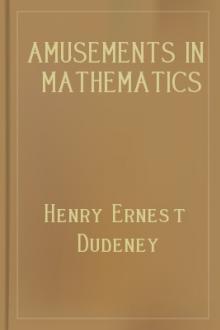Amusements in Mathematics, Henry Ernest Dudeney [books to read to be successful txt] 📗

- Author: Henry Ernest Dudeney
- Performer: 0486204731
Book online «Amusements in Mathematics, Henry Ernest Dudeney [books to read to be successful txt] 📗». Author Henry Ernest Dudeney
The area of our triangle ADB is clearly half of 9 × 17, or 76½ acres. The area of AEC is half of 5 × 7, or 17½ acres; the area of CFB is half of 4 × 10, or 20 acres; and the area of the oblong EDFC is obviously 4 × 7, or 28 acres. Now, if we add together 17½, 20, and 28 = 65½, and deduct this sum from the area of the large triangle ADB (which we have found to be 76½ acres), what remains must clearly be the area of ABC. That is to say, the area we want must be 76½ - 65½ = 11 acres exactly.
190.—FARMER WURZEL'S ESTATE.—solution
The area of the complete estate is exactly one hundred acres. To find this answer I use the following little formula,
/4ab - (a + b + c)²;
_____________________
4
where a, b, c represent the three square areas, in any order. The expression gives the area of the triangle A. This will be found to be 9 acres. It can be easily proved that A, B, C, and D are all equal in area; so the answer is 26 + 20 + 18 + 9 + 9 + 9 + 9 = 100 acres.

Here is the proof. If every little dotted square in the diagram represents an acre, this must be a correct plan of the estate, for the squares of 5 and 1 together equal 26; the squares of 4 and 2 equal 20; and the squares of 3 and 3 added together equal 18. Now we see at once that the area of the triangle E is 2½, F is 4½, and G is 4. These added together make 11 acres, which we deduct from the area of the rectangle, 20 acres, and we find that the field A contains exactly 9 acres. If you want to prove that B, C, and D are equal in size to A, divide them in two by a line from the middle of the longest side to the opposite angle, and you will find that the two pieces in every case, if cut out, will exactly fit together and form A.
Or we can get our proof in a still easier way. The complete area of the squared diagram is 12 × 12 = 144 acres, and the portions 1, 2, 3, 4, not included in the estate, have the respective areas of 12½, 17½, 9½, and 4½. These added together make 44, which, deducted from 144, leaves 100 as the required area of the complete estate.
191.—THE CRESCENT PUZZLE.—solution
Referring to the original diagram, let AC be x, let CD be x - 9, and let EC be x - 5. Then x - 5 is a mean proportional between x - 9 and x, from which we find that x equals 25. Therefore the diameters are 50 in. and 41 in. respectively.
192.—THE PUZZLE WALL.—solution

The answer given in all the old books is that shown in Fig. 1, where the curved wall shuts out the cottages from access to the lake. But in seeking the direction for the "shortest possible" wall most readers to-day, remembering that the shortest distance between two points is a straight line, will adopt the method shown in Fig. 2. This is certainly an improvement, yet the correct answer is really that indicated in Fig. 3. A measurement of the lines will show that there is a considerable saving of length in this wall.
193.—THE SHEEP-FOLD.—solution
This is the answer that is always given and accepted as correct: Two more hurdles would be necessary, for the pen was twenty-four by one (as in Fig. A on next page), and by moving one of the sides and placing an extra hurdle at each end (as in Fig. B) the area would be doubled. The diagrams are not to scale. Now there is no condition in the puzzle that requires the sheep-fold to be of any particular form. But even if we accept the point that the pen was twenty-four by one, the answer utterly fails, for two extra hurdles are certainly not at all necessary. For example, I arrange the fifty hurdles as in Fig. C, and as the area is increased from twenty-four "square hurdles" to 156, there is now accommodation for 650 sheep. If it be held that the area must be exactly double that of the original pen, then I construct it (as in Fig. D) with twenty-eight hurdles only, and have twenty-two in hand for other purposes on the farm. Even if it were insisted that all the original hurdles must be used, then I should construct it as in Fig. E, where I can get the area as exact as any farmer could possibly require, even if we have to allow for the fact that the sheep might not be able to graze at the extreme ends. Thus we see that, from any point of view, the accepted answer to this ancient little puzzle breaks down. And yet attention has never before been drawn to the absurdity.

194.—THE GARDEN WALLS.—solution
The puzzle was to divide the circular field into four equal parts by three walls, each wall being of exactly the same length. There are two essential difficulties in this problem. These are: (1) the thickness of the walls, and (2) the condition that these walls are three in number. As to the first point, since we are told that the walls are brick walls, we clearly cannot ignore their thickness, while we have to find a solution that will equally work, whether the walls be of a thickness of one, two, three, or more bricks.

The second point requires a little more consideration. How are we to distinguish between a wall and walls? A straight wall without any bend in it, no matter how long, cannot ever become "walls," if it is neither broken nor intersected in any way. Also our circular field is clearly enclosed by one wall. But if it had happened to be a square or a triangular enclosure, would there be respectively four and three walls or only one enclosing wall in each case? It is true that we speak of "the four walls" of a square building or garden, but this is only a conventional way of saying "the four sides." If you were speaking of the actual brickwork, you would say, "I am going to enclose this square garden with a wall." Angles clearly do not affect the question, for we may have a zigzag wall just as well as a straight one, and the Great Wall of China is a good example of a wall with plenty of angles. Now, if you look at Diagrams 1, 2, and 3, you may be puzzled to declare whether there are in each case two or four new walls; but you cannot call them three, as required in our puzzle. The intersection either affects the question or it does not affect it.
If you tie two pieces of string firmly together, or splice them in a nautical manner, they become "one piece of string." If you simply let them lie across one another or overlap, they remain "two pieces of string." It is all a question of joining and welding. It may similarly be held that if two walls be built into one another—I might almost say, if they be made homogeneous—they become one wall, in which case Diagrams 1, 2, and 3 might each be said to show one wall or two, if it be indicated that the four ends only touch, and are not really built into, the outer circular wall.
The objection to Diagram 4 is that although it shows the three required walls (assuming the ends are not built into the outer circular wall), yet it is only absolutely correct when we assume the walls to have no thickness. A brick has thickness, and therefore the fact throws the whole method out and renders it only approximately correct.
Diagram 5 shows, perhaps, the only correct and perfectly satisfactory solution. It will be noticed that, in addition to the circular wall, there are three new walls, which touch (and so enclose) but are not built into one another. This solution may be adapted to any desired thickness of wall, and its correctness as to area and length of wall space is so obvious that it is unnecessary to explain it. I will, however, just say that the semicircular piece of ground that each tenant gives to his neighbour is exactly equal to the semicircular piece that his neighbour gives to him, while any section of wall space found in one garden is precisely repeated in all the others. Of course there is an infinite number of ways in which this solution may be correctly varied.
195.—LADY BELINDA'S GARDEN.—solution

All that Lady Belinda need do was this: She should measure from A to B, fold her tape in four and mark off the point E, which is thus one quarter of the side. Then, in the same way, mark off the point F, one-fourth of the side AD Now, if she makes EG equal to AF, and GH equal to EF, then AH is the required width for the path in order that the bed shall be exactly half the area of the garden. An exact numerical measurement can only be obtained when the sum of the squares of the two sides is a square number. Thus, if the garden measured 12 poles by 5 poles (where the squares of 12 and 5, 144 and 25, sum to 169, the square of 13), then 12 added to 5, less 13, would equal four, and a quarter of this, 1 pole, would be the width of the path.
196.—THE TETHERED GOAT.—solution

This problem is quite simple if properly attacked. Let us suppose the triangle ABC to represent our half-acre field, and the shaded portion to be the quarter-acre over which the goat will graze when tethered to the corner C. Now, as six equal equilateral triangles placed together will form a regular hexagon, as shown, it is evident that the shaded pasture is just one-sixth of the complete area of a circle. Therefore all we require is the radius (CD) of a circle containing six quarter-acres or 1½ acres, which is equal to 9,408,960 square inches. As we only want our answer "to the nearest inch," it is sufficiently exact for our purpose if we assume that as 1 is to 3.1416, so is the diameter of a circle to its circumference. If, therefore, we divide the last number I gave by 3.1416, and extract the square root, we find that 1,731 inches, or 48 yards 3 inches, is the required length of the tether "to the nearest inch."
197.—THE COMPASSES PUZZLE.—solution
Let AB in the following diagram be the given straight line. With the centres A and B and radius AB describe the two circles. Mark off DE and EF equal to AD. With the centres A and F and radius DF describe arcs intersecting at G. With the centres A and B and distance BG describe arcs GHK and N. Make HK equal to AB and HL equal to HB. Then with centres K and L and radius AB describe arcs intersecting at I. Make BM equal to BI. Finally, with the centre M and radius MB





Comments (0)